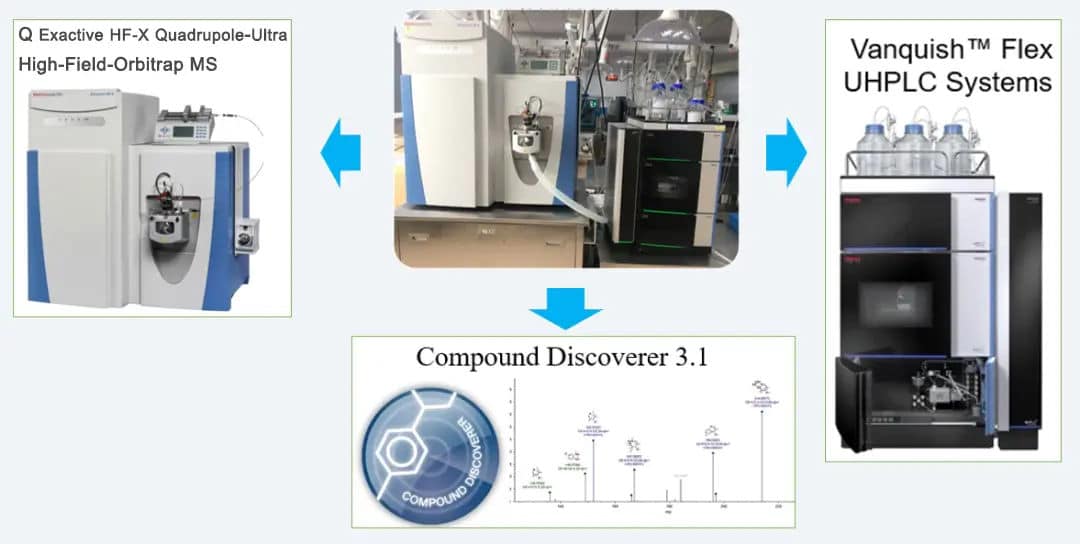Metabolite identification

Introduction
Metabolite identification is a method of analyzing metabolic products in an organism to understand its metabolic process, physiological state, and disease development. Metabolites refer to compounds formed due to metabolic processes in organisms, including organic acids, amino acids, sugars, lipids, etc. Qualitative and quantitative analysis of these metabolites can reveal the activity of different metabolic pathways in organisms, identify new physiological indicators and disease markers, and provide a basis for drug development and clinical diagnosis.
Metabolite Analysis Technology
Liquid Chromatography-Mass Spectrometry (LC-MS)
Liquid chromatography-mass spectrometry is currently one of the most commonly used metabolite analysis techniques. It combines liquid chromatography and mass spectrometry technology to achieve highly sensitive and highly selective detection and quantification of various compounds in complex samples. In LC-MS analysis, the sample is first separated through a liquid chromatography column and then enters the mass spectrometer for ionization and mass screening. Finally, the types and contents of metabolites are determined by detecting ion signals.
Gas Chromatography-Mass Spectrometry (GC-MS)
Gas chromatography-mass spectrometry is another commonly used technique for metabolite analysis. It combines gas chromatography with mass spectrometry technology and is suitable for the analysis of volatile or semi-volatile compounds. In GC-MS analysis, the sample is first separated through a gas chromatography column and then enters the mass spectrometer for ionization and mass screening. Finally, the types and contents of metabolites are determined by detecting ion signals.
Nuclear Magnetic Resonance (NMR)
NMR is a non-invasive metabolite analysis technique that can provide detailed information about the structure and composition of metabolites. In NMR analysis, a sample is placed in a strong magnetic field, radio frequency pulses of a specific frequency are applied to the sample, and the signal in response to the sample is measured. Different compounds have different NMR signals, and the type and content of metabolites can be determined by analyzing these signals.
Application of Metabolite Identification in Life Sciences
1. Metabolic pathway research
Through the analysis of metabolites, the activities and interactions of different metabolic pathways can be understood. For example, in the study of lipid metabolism, by analyzing the types and contents of fatty acid metabolites, the activity levels of fatty acid synthesis and degradation pathways can be revealed, providing a basis for the treatment of obesity and other related diseases.
2. Disease marker screening
Many diseases cause abnormalities in specific metabolic pathways. By analyzing metabolites in a patient’s body fluids or tissues, markers related to specific diseases can be discovered. For example, increased levels of lactic acid in the urine of cancer patients may be a sign of lactic acidosis, while decreased levels of alanine in the blood may be related to impaired erythropoiesis.
3. Pharmacokinetics
Drugs undergo a series of metabolic reactions in the body and are converted into metabolites. By analyzing drugs and their metabolites in in vivo and in vitro samples, the metabolic process, kinetic characteristics and pharmacodynamic parameters of the drug in the body can be understood. This has important implications for drug efficacy evaluation, dose optimization, and drug interaction studies.
Challenges and Developments in Metabolite Identification
1. Sample preparation
Sample preparation is a critical step in metabolite identification. Metabolites are present in large numbers in complex biological samples, and their concentrations range from micromolar to nanomolar. Therefore, appropriate sample preparation methods need to be selected to improve the detection sensitivity and selectivity of metabolites.
2. Data analysis
The data obtained from metabolite analysis are often very large and complex. Processing and analyzing this data effectively is a challenge. Currently, emerging technologies such as machine learning and artificial intelligence are widely used in metabolite data analysis to improve the accuracy of data interpretation and marker screening.
3. Standardization and database construction
In order to achieve comparability of results between different laboratories or research institutions, it is necessary to establish a unified standardized method and establish a database containing information on various metabolites. This will help accelerate the discovery of new physiological indicators and disease markers and promote the further development of metabolite identification technology.
Conclusion
Metabolite identification is an important life science research method. Analysis of metabolites can reveal the activity and interaction of different metabolic pathways in organisms, discover new physiological indicators and disease markers, and provide information for drug development and clinical diagnosis. in accordance with. With the continuous advancement of technology and the optimization of data analysis methods, metabolite identification will play an increasingly important role in the field of life sciences.
